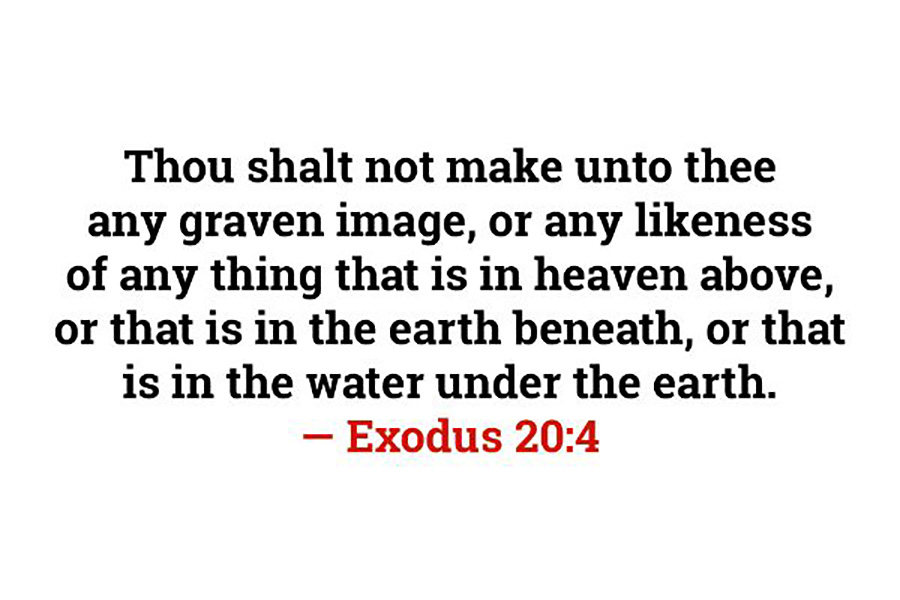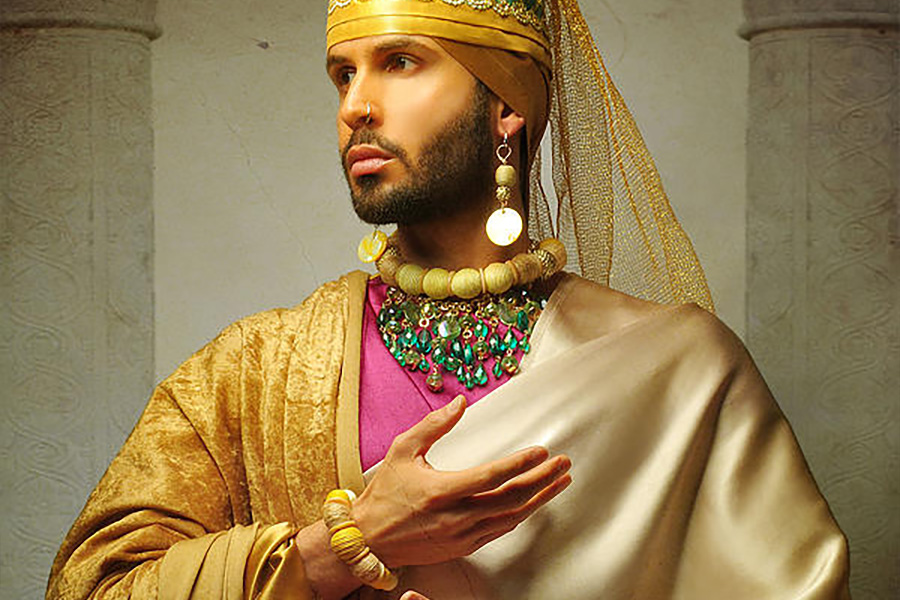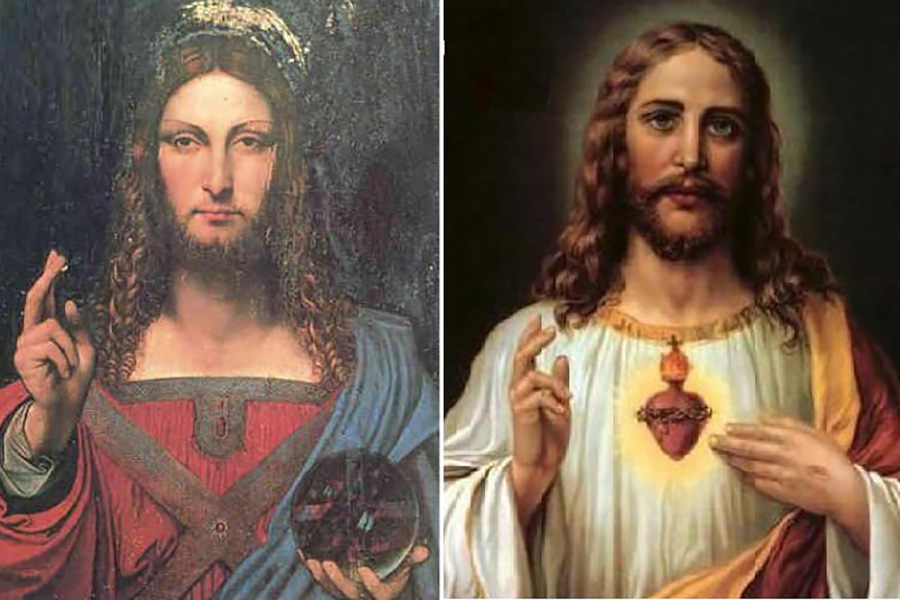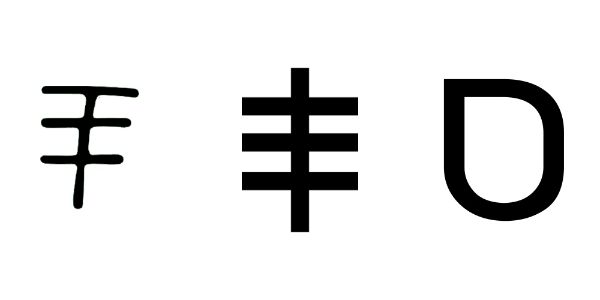The word Yahayashayaā (𐤉𐤄𐤉𐤔𐤉𐤏) means “He who creates is salvation” and is the third-person proper name of the Messiah.
The Paleo-Hebrew language or the original language of the Ābarayam is one spoken with an emphasis on the rauakh (breath, wind, spirit). With the language of the Ābarayam, each letter has a meaning and a number associated with it that adds meaning to each word they’re used with. Below you will be able to learn more about the letter in Ancient Hebrew, Yiddish Hebrew, Greek, and much more.
Letter Meanings
| Letter | Meaning |
|---|---|
| 𐤉 (y) – ya | Arm, hand, work, thrust, deed, make, throw, worship Prefix: he/she, turns a word third person |
| 𐤄 (h) – ha | Look, Behold, The, Reveal, breath (life), man |
| 𐤉 (y) – ya | Arm, hand, work, thrust, deed, make, throw, worship |
| 𐤔 (sh) – sha | teeth, eat, consume, destroy, bite, two, change, divide, press, repeat |
| 𐤉 (y) – ya | Arm, hand, work, thrust, deed, make, throw, worship |
| 𐤏 (ā) – ā | eye, to see, experience, watch, heed, know, cover, color |
| Ābarayat Number | 405 = 10 (y) + 5 (h) + 10 (y) + 300 (sh) + 10 (y) + 70 (ā) |
| Hebrew Gematria | 1312 = 400 (y) + 1 (a) + 8 (h) + 1 (a) + 400 (y) + 1 (a) + 90 (s) + 80 (h) + 1 (a) + 400 (y) + 1 (a) + 1 (a) |
| English Gematria | 696 = 150 (y) + 6 (a) + 48 (h) + 6 (a) + 150 (y) + 6 (a) + 114 (s) + 48 (h) + 6 (a) + 150 (y) + 6 (a) + 6 (a) |
| Simple Gematria | 116 = 25 (y) + 1 (a) + 8 (h) + 1 (a) + 25 (y) + 1 (a) + 19 (s) + 8 (h) + 1 (a) + 25 (y) + 1 (a) + 1 (a) |
Based on the meaning of the letters the word could be defined as:
- “He who creates will save”
- “Yah will save”
- “He who creates is salvation”
- “Yah is salvation”
- “He who creates life creates a cry for help”
- Combines Ya and Hayashayaā (save or the savior)
- Combines Ya and Ha and Yashayaā (he will save)
- Combines Yah and Yashayaā (he will save)
- Combines Yah and Yash and Yaā
- Yah = “He who creates”
- Yash = “She who consumes”, entity, sleep
- Yaā = shovel, sweep together, sweep away
- Combines Yahay and Shayaā (to cry out for help)
- Combines Yah and hayash (over there) and yaā
Definitions for 𐤉𐤄𐤉𐤔𐤉𐤏 / Yahayashayaā
| Language | Word | Transliteration | Pronunciation | Definition |
|---|---|---|---|---|
| Ābarayat | 𐤉𐤄𐤉𐤔𐤉𐤏 | Yahayashayaā | yaw-yasha-yeh | “Yah is salvation,” Potentially written as Yahayashayagh (pronounced: yaw-yasha-yagh). |
| English | Jesus | Jesus | jee-zuhs | the supreme example of God’s nature expressed through human beings. |
| Hebrew | יְהיְשׁיְעַ | Yehoshua | yeh-ho-shoo’-ah | “the LORD is salvation,” |
| Arabic | يهوشوا | yehoshua | yeh-ho-shoo’-ah | Joshua |
| Greek | Ἰησοῦς | Iésous | ee-ay-sooce’ | Jesus or Joshua, the name of the Messiah |
Images for 𐤉𐤄𐤉𐤔𐤉𐤏 / Yahayashayaā


Alternative Spellings
Due to possible mistranslations of the word an alternative spelling of the word is:
- 𐤉𐤄𐤅𐤔𐤅𐤏 (Yahauashauaā)
- 𐤉𐤄𐤉𐤔𐤏 (Yahayashaā)
- 𐤉𐤄𐤅𐤔𐤏 (Yahauashaā)
𐤉𐤄𐤉𐤔𐤉𐤏 (Yahayashayaā) and 𐤀𐤄𐤉𐤔𐤉𐤏 (Ahayashayaā)
The melanin-deficient (white milk-colored) false idol named Jesus replaced the Ābaray Messiah name of 𐤉𐤄𐤉𐤔𐤉𐤏 (Yahayashayaā). The name is identified by the Strong’s Hebrew to mean Yah is salvation. Furthermore, if his name follows the same pattern as 𐤀𐤄𐤉𐤄 (Ahayah) and 𐤉𐤄𐤉𐤄 (Yahayah) for first-person versus third-person then his name would also be 𐤀𐤄𐤉𐤔𐤉𐤏 (Ahayashayaā) for first-person.
Ya + Hayashayaā Combination
If his name follows this pattern then it combines 𐤀 (alaph) or 𐤉 (yad) with 𐤄𐤉𐤔𐤉𐤏 (hayashayaā). 𐤄𐤉𐤔𐤉𐤏 (hayashayaā) is translated to mean “save”. However, when you reference it as 𐤄𐤉𐤔𐤉𐤏 (ha-yashayaā) it becomes “the savior” since 𐤄 (ha) signifies “the” in most cases when attached to a word.
From these combinations, his name could mean:
- “He who saves”
- “He who is the savior”
Yah + Yashayaā Combination
His name could be a combination of his father’s name 𐤉𐤄 (Yah) and the word 𐤉𐤔𐤉𐤏 (Yashayaā). This would follow a similar pattern to 𐤉𐤄𐤉𐤃𐤄 (Yahayadah). However, instead of being “Yah is praise”, his name would be “Yah is deliverance” or “Yah is a deliverer”
Yah + Yash + Yaā Combination
His name could be a combination of his father’s abbreviated name 𐤉𐤄 (Yah) from 𐤉𐤄𐤉𐤄 (Yahayah) and his speculated mother’s abbreviated name the 𐤉𐤔 (Yash) from 𐤉𐤔𐤓𐤄 (Yasharah) and the word 𐤉𐤏 (yaā). The word 𐤉𐤏 (yaā) can mean “shovel”, “sweep together (to gather)”, or “sweep away”. Based on this his name could also mean “The Father, The Mother, The Gatherer”. This aligns with 𐤌𐤕𐤕𐤉𐤄 (Matatayah) 23:37, where he calls himself the gatherer of the children of the people.
The Messiah declares himself to be the great gatherer. He came first to the lost sheep of the house of 𐤉𐤔𐤓𐤀𐤋 (Yasharaal). He came to his own and his own received him not. Even 𐤒𐤉𐤐𐤀 (Qayaphaa) aka Caiaphas, the high priest, prophesied that 𐤉𐤄𐤉𐤔𐤉𐤏 (Yahayashayaā) should “gather together in one the children of 𐤉𐤄 (Yah) that were scattered abroad” (Yauachanan 11:52). 𐤉𐤄𐤉𐤔𐤉𐤏 (Yahayashayaā) is the Gatherer of His people, the 𐤒𐤄𐤋 (Qahal) aka Ecclesia, the out-called ones. 𐤉𐤄 (Yah) is not converting the world, but taking out a people for His name (Maāshah 15:14).
Yah + Yashaā Combination
The recorded word origin of his name is 𐤉𐤄𐤉𐤄 (Yahayah) and 𐤉𐤔𐤏 (yashaā). The word 𐤉𐤔𐤏 (yashaā) means “to deliver”, “avenging”, “defend”, “deliverer”, “help”, “preserve”, “rescue”, and “be safe”. Thus, if we take the 𐤉 (yad) out of the latter portion of his name we can make this alternative spelling. This would provide us with “Yah is a deliverer”, “Yah is a defender”, “Yah helps”, “Yah is a preserver”, or “Yah is a rescuer”.
𐤉𐤄𐤉𐤔𐤉𐤏 (Yahayashayaā) in History

𐤉𐤄𐤉𐤔𐤉𐤏 (Yahayashayaā) was born in the 𐤄𐤅𐤓𐤃𐤅𐤎 (Hauaradauas) 𐤌𐤌𐤋𐤊𐤄 (mamalakah) 𐤉𐤄𐤉𐤃 (Yahayad) aka the Herodian Kingdom of Judea, under the 𐤓𐤅𐤌𐤀𐤉 (Rauamaay) 𐤀𐤉𐤌𐤐𐤓𐤉𐤄 (Ayamaparayah) aka Roman Empire.
The Herodian dynasty was a royal dynasty of Idumaean (Edomite) descent, ruling the Herodian Kingdom and later the Herodian Tetrarchy, as a vassal state of the Roman Empire. The Herodian dynasty began with Herod the Great, who assumed the throne of Judea, with Roman support, bringing down the century-long Hasmonean Kingdom. His kingdom lasted until his death in 4 BCE when it was divided between his sons as a Tetrarchy, which lasted for about 10 years.
Most of those tetrarchies, including Judea proper, were incorporated into Judaea Province from 6 CE, though limited Herodian de facto kingship continued until Agrippa I’s death in 44 CE and nominal title of kingship continued until 92 CE when the last Herodian monarch, Agrippa II, died and Rome assumed full power over his de jure domain.
𐤉𐤄𐤉𐤔𐤉𐤏 (Yahayashayaā) was a first-century 𐤉𐤄𐤉𐤃𐤄𐤉 (Yahayadahay) preacher and messenger. He is the central figure of Christianity and Catholicism, the world’s largest religions. Most Christians believe he is the incarnation of “God the Son” and the awaited 𐤌𐤔𐤉𐤇 (Mashayakh) prophesied in the Ābaray scriptures.
Virtually all modern scholars of antiquity agree that 𐤉𐤄𐤉𐤔𐤉𐤏 (Yahayashayaā) existed historically. Research into the historical 𐤉𐤄𐤉𐤔𐤉𐤏 (Yahayashayaā) has yielded some uncertainty on the historical reliability of the Gospels and on how closely the 𐤉𐤄𐤉𐤔𐤉𐤏 (Yahayashayaā) portrayed in the New Testament reflects the historical 𐤉𐤄𐤉𐤔𐤉𐤏 (Yahayashayaā), as the only detailed records of 𐤉𐤄𐤉𐤔𐤉𐤏 (Yahayashayaā)’s life are contained in the Gospels.
𐤉𐤄𐤉𐤔𐤉𐤏 (Yahayashayaā) is also revered in other religions. In Islam, 𐤉𐤄𐤉𐤔𐤉𐤏 (Yahayashayaā) [often referred to by his Quranic name عِيسَى (ʿĪsā)] is considered the penultimate prophet of God and the Messiah. Muslims believe 𐤉𐤄𐤉𐤔𐤉𐤏 (Yahayashayaā) was born of the virgin 𐤌𐤓𐤉𐤌 (Marayam) (another figure revered in Islam) but was neither God nor a son of God.
The Quran states that 𐤉𐤄𐤉𐤔𐤉𐤏 (Yahayashayaā) never claimed to be divine. Most Muslims do not believe that he was killed or crucified, but that God raised him into Heaven while he was still alive. In contrast, Judaism rejects the belief that 𐤉𐤄𐤉𐤔𐤉𐤏 (Yahayashayaā) was the awaited messiah, arguing that he did not fulfill messianic prophecies, and was neither divine nor resurrected.
𐤉𐤄𐤉𐤔𐤉𐤏 (Yahayashayaā) was 𐤉𐤄𐤉𐤃𐤄𐤉 (Yahayadahay), born to 𐤌𐤓𐤉𐤌 (Marayam), wife of 𐤉𐤅𐤎𐤐 (Yauasaph). The Gospels of 𐤌𐤕𐤕𐤉𐤄 (Matatayah) and 𐤋𐤅𐤒 (Lauaq) offer two accounts of his genealogy. 𐤌𐤕𐤕𐤉𐤄 (Matatayah) traces 𐤉𐤄𐤉𐤔𐤉𐤏 (Yahayashayaā)’s ancestry to 𐤀𐤁𐤓𐤄𐤌 (Abaraham) through 𐤃𐤅𐤃 (Dauad). 𐤋𐤅𐤒 (Lauaq) traces 𐤉𐤄𐤉𐤔𐤉𐤏 (Yahayashayaā)’s ancestry through 𐤀𐤃𐤌 (Adam) to 𐤉𐤄𐤉𐤄 (Yahayah).
The lists are identical between 𐤀𐤁𐤓𐤄𐤌 (Abaraham) through 𐤃𐤅𐤃 (Dauad) but differ radically from that point. 𐤌𐤕𐤕𐤉𐤄 (Matatayah) has 27 generations from 𐤃𐤅𐤃 (Dauad) to 𐤉𐤅𐤎𐤐 (Yauasaph), whereas 𐤋𐤅𐤒 (Lauaq) has 42, with almost no overlap between the names on the two lists. Various theories have been put forward to explain why the two genealogies are so different.
𐤌𐤕𐤕𐤉𐤄 (Matatayah) and 𐤋𐤅𐤒 (Lauaq) each describe 𐤉𐤄𐤉𐤔𐤉𐤏 (Yahayashayaā)’s birth, especially that 𐤉𐤄𐤉𐤔𐤉𐤏 (Yahayashayaā) was born to a virgin named 𐤌𐤓𐤉𐤌 (Marayam) in 𐤁𐤉𐤕 𐤋𐤇𐤌 (Bayat Lakham) in fulfillment of prophecy. 𐤋𐤅𐤒 (Lauaq)’s account emphasizes events before the birth of 𐤉𐤄𐤉𐤔𐤉𐤏 (Yahayashayaā) and centers on 𐤌𐤓𐤉𐤌 (Marayam), while 𐤌𐤕𐤕𐤉𐤄 (Matatayah)’s account mostly covers those after the birth and centers on 𐤉𐤅𐤎𐤐 (Yauasaph).
Both accounts state that 𐤉𐤄𐤉𐤔𐤉𐤏 (Yahayashayaā) was born to 𐤉𐤅𐤎𐤐 (Yauasaph) and 𐤌𐤓𐤉𐤌 (Marayam), his betrothed, in 𐤁𐤉𐤕 𐤋𐤇𐤌 (Bayat Lakham), and both support the doctrine of the virgin birth of 𐤉𐤄𐤉𐤔𐤉𐤏 (Yahayashayaā), according to which 𐤉𐤄𐤉𐤔𐤉𐤏 (Yahayashayaā) was miraculously conceived by the 𐤓𐤅𐤇 𐤒𐤃𐤔 (Rauakh Qadash) in 𐤌𐤓𐤉𐤌 (Marayam)’s womb when she was still a virgin.
At the same time, there is evidence, at least in the Lukan Acts of the Apostles, that 𐤉𐤄𐤉𐤔𐤉𐤏 (Yahayashayaā) was thought to have had, like many figures in antiquity, a dual paternity, since there it is stated he descended from the seed or loins of 𐤃𐤅𐤃 (Dauad). By taking him as his own, 𐤉𐤅𐤎𐤐 (Yauasaph) will give him the necessary Davidic descent.
After 𐤉𐤄𐤉𐤔𐤉𐤏 (Yahayashayaā)’s life, his followers, as described in the first chapters of the Acts of the Apostles, were all 𐤉𐤄𐤉𐤃𐤄𐤉 (Yahayadahay) either by birth or conversion, for which the biblical term “proselyte” is used, and referred to by historians as “Jewish Christians”. The early Gospel message was spread orally, probably in Aramaic, but almost immediately also in Greek. The Romans spoke Latin in their main territory of Rome and were the conquerors of Greece.
However, after the conquest of Alexander the Great, Greek became a “lingua franca” or bridge language in the extensive territories of his conquests, though Rome wasn’t much affected by this. Eventually, Latin seems to regain prominence in Roman Empire, while Greek becomes the language of the Eastern Roman Empire.
The canonical texts, which have become the main sources used by historians to try to understand the historical 𐤉𐤄𐤉𐤔𐤉𐤏 (Yahayashayaā) and sacred texts within Christianity, were probably written between 50 and 120 AD. They were then modified in 325 AD by the First Council of Nicaea under orders of the Roman Emperor Constantine I. We will discuss this more in the Erasure of 𐤉𐤄𐤉𐤔𐤉𐤏 (Yahayashayaā) section of this entry.
The 𐤌𐤔𐤉𐤇 (Mashayakh) and Other Titles

𐤉𐤄𐤉𐤔𐤉𐤏 (Yahayashayaā) has many titles that he has been called over the years. The most prominent one is Christ, which is where Christianity derives from. However, Christ or χριστού (Christos) in Greek is their replacement for 𐤌𐤔𐤉𐤇 (Mashayakh) in Ābarayat or Messiah in English.
Technically, Messianic Judaism is probably more aligned than Christianity when it comes to 𐤉𐤄𐤉𐤔𐤉𐤏 (Yahayashayaā). That being said, 𐤌𐤔𐤉𐤇 (Mashayakh) means anointed or anointed ones. It derives from the word used for smearing or anointing someone with oil on their head.
The Greek word χριστού (Christos) also means anointed one and comes from the word used to consecrate by anointing.
Some of the other titles that 𐤉𐤄𐤉𐤔𐤉𐤏 (Yahayashayaā) has been called are:
- Jesus of Nazareth = 𐤉𐤄𐤅𐤔𐤅𐤏 𐤍𐤑𐤓𐤕 (Yahauashauaā Natsarat)
- Immanuel/Emmanuel = 𐤏𐤌𐤍𐤅𐤀𐤋 (Āmanauaal)
- Savior = 𐤉𐤔𐤉𐤏 (Yashayaā)
- Gatherer = 𐤉𐤏 (Yaā)
- Almighty
- Alpha and Omega
- Advocate
- Rabbi
- Founder and Perfector
- Authority
- Bread of Life
- Beloved Son of God
- Counselor
- Creator
- Chief Shepherd
- The Bridegroom
- The Bread of Life
- Deliverer
- The Door
- Eternal
- Faithful and True
- God
- Good Shepherd
- Great High Priest
- Head of the Church
- Holy Servant
- I am
- Indescribable Gift
- Judge
- King of Kings
- Lamb of God
- The Life
- Light of the World
- Lion of the Tribe of Judah
- Lord of All
- One Who Sets Free
- Our Hope
- Peace
- Prophet
- The Resurrection
- Risen Lord
- The Rock (not Dwayne Johnson)
- Sacrifice for Our Sins
- Son of Man
- Son of the Most High
- Supreme Creator Over All
- True Vine
- The Truth
- Victorious One
- The Way
- The Word
The canonical texts, which have become the main sources used by historians to try to understand the historical 𐤉𐤄𐤉𐤔𐤉𐤏 (Yahayashayaā) and sacred texts within Christianity, were probably written between 50 and 120 AD. They were then modified in 325 AD by the First Council of Nicaea under orders of the Roman Emperor Constantine I. We will discuss this more in the Erasure of 𐤉𐤄𐤉𐤔𐤉𐤏 (Yahayashayaā) section of this entry.
Erasure of 𐤉𐤄𐤉𐤔𐤉𐤏 (Yahayashayaā) in History

Under orders of the Roman Emperor Constantine I the First Council of Nicaea in 325 AD modified and altered the scriptures of the Ābaray. A similar situation occurred when the 𐤁𐤏𐤋𐤉 𐤄𐤌𐤎𐤅𐤓𐤄 (Baālay Hamasauarah) aka Masoretes or “Masters of the Tradition” or “The Devoted of Ba’al” modified the original covenant scriptures between circa 476 AD when the Western Roman Empire fell and late 900 to 999 AD.
Before the erasure, 𐤉𐤄𐤉𐤔𐤉𐤏 (Yahayashayaā) probably looked like a typical 𐤉𐤄𐤉𐤃𐤄𐤉 (Yahayadahay) man of his time and place; standing around 166 cm (5 ft 5 in) tall with a thin but fit build, olive-brown skin, brown eyes, and possibly locked dark hair similar to the dreadlock hairstyle.
He also likely had a beard that was not particularly long or heavy. His clothing may have suggested poverty consisting of a mantle (shawl) with Tzitzit (tassels), a knee-length basic tunic, and sandals.
The Greek and Roman Military Force (BC)
Ptolemy 1 Meryamun Setepenre (c.a. 367-283 BC) (aka Soter) (“Soter” means savior) became the first European pharaoh of Egypt through military force led by Alexander the Greek (aka Alexander the Great). When Ptolemy became pharaoh of Egypt, he wanted the Egyptians to consecrate him as a god. The term ‘Pharaoh’ was not used in Egypt to describe their ruler until the time of Merneptah around c. 1200 BC. Ptolemy 1 wanted to be called a god because that was the title all of the pharaohs of Egypt were called prior to him.
However, the people of Egypt refused to call him a god because they knew the only reason he became a pharaoh was through force, so in 305 BC – Ptolemy took the title of Pharaoh, taking the Egyptian name Meryamun Setepenre, which means “Beloved of Amun (Amun means god) Chosen of Ra (Ra means god)”, and because of the Egyptians refusal to acknowledge him as a god, he began killing the people of Egypt, which caused the Egyptian priests at Memphis to give in to his request by agreeing to consecrate him to the priesthood, in order to save their own lives.
Ptolemy’s role was to create a deity that would be worshiped by both the Egyptians and the Greeks. He created “Serapis “, the made-up Graeco-Egyptian god that was invented in the 3rd century BC, portrayed as Greek in appearance, but with Egyptian accessories, representing both wealth and resurrection.
The Greek and Roman Military Force (AD)
Up until the First Council of Nicaea, the Roman aristocracy primarily worshipped two Greek gods-Apollo and Zeus-but the great bulk of common people idolized either Julius Caesar or Mithras (the Romanized version of the Persian deity Mithra who was an incarnation of the Babylonian Tammuz). Apollo is the son of Zeus, and he is a sun god. Apollo is referenced in the scriptures as Apollyon or the Destroyer.
Constantine the Greek (a.k.a Constantine the Great) Roman Emperor from 306 AD to 337 AD, is known for being the first Roman emperor to be converted to Christianity which strangely enough, Arius of Libya (256-356 AD) who was born of African descent centuries after Ptolemy 1, had a problem with the Roman empire teaching the Africans and the people of Rome to worship a statue and celebrating death.
Arius, the creator of Arianism, was considered a heretic, a professed believer (of God), who maintains religious opinions contrary to those accepted by his or her church (what the religious authorities usually controlled by the government deem as the truth). Because he started attracting so many followers due to his teachings that were contrary to the Romans, Constantine called the council by summoning all the bishops to discredit Arius, The Council of Nicaea.
During the time when this meeting was called upon, there was no mention of Jesus Christ at all; no man had ever existed by the name JESUS Christ, and an important fact is that this all took place Anno Domino (A.D.) (which Christians claim means after the death of Christ) in Latin means ‘in the year of the lord’. The name Jesus Christ didn’t exist before the meeting was called. It was only after this that they presented to the people the name JESUS CHRIST.
During the Council of Nicaea, they were charged by the Roman leadership to create a unified Christian religion and they created their own god in place of 𐤉𐤄𐤉𐤔𐤉𐤏 (Yahayashayaā) and called him Ἰησοῦς (Iésous). Constantine’s true intention at Nicea, and not the one that’s recorded in history, was to create an entirely new god for his empire who would unite all religious factions under one deity. Presbyters were asked to debate and decide who their god would be.
Delegates argued among themselves, expressing personal motives for the inclusion of particular writings that promoted the finer traits of their own special deity. Throughout the meeting, howling factions were immersed in heated debates, and the names of 53 gods were tabled for discussion. At the end of that time, Constantine returned to the gathering to discover that the presbyters had not agreed on a new deity, but had balloted down to a short list of five prospects: Caesar, Crishna [Krishna], Mithra, Horus, and Zeus [Roman Jupiter].
Constantine was the ruling spirit at Nicaea and he ultimately decided upon a new god for them. To involve British factions, he ruled that the name of the Druid god, “Hesus” or “Esus,” be joined with the Eastern Savior-god, Krishna (Krishna is Sanskrit for Christ), and thus “Hesus Krishna” [Jesus Christ] would be the official name of the New Roman god. A vote was taken and it was with a majority show of hands (161 votes to 157) that both [man-made] divinities become one god. Following long-standing heathen custom, Constantine used the official gathering and the Roman apotheosis decree to legally deify two deities as one and did so by democratic consent. A new god was proclaimed and “officially” ratified by Constantine.
Simply, no one was a “Christian” prior to 325 AD. All the churches that claim to be Christian today are merely daughters of the universal Roman Catholic stylized system of false worship of “Hail Zeus-Christna,” with their own sanctified spin and variation on doctrinal beliefs. Prior to that year all of the Messiah’s obedient early believers referred to themselves as the Natsarim (Nazarenes) or were called the Quartodecimen (Fourteeners), who kept Passover by counting to the 14th day from the full New Month, as their very name reveals.
The Meaning Behind the Name
The word Ἰησοῦς (Iésous) can be written as Iesus in the Latin language which combines Ie meaning “hail” and sus, which is speculated to be in reference to Zeus but also means pig; thus, making his name read “Hail Zeus” or “Hail pig”. They had a similar naming convention to the Ābaray and paid homage to their chief supreme being, in this case, Zeus. The Greeks ended cities and names using “sous/sus/us” like we used “yah/al” as beginnings or endings. For example, Julius Caesar, Gaius Julius, and the Roman Emperor who created Roman Catholicism and Christianity, Flavius Valerius Aurelius Constantinus Augustus. Just like they replaced 𐤉𐤄𐤉𐤄 (Yahayah)’s name for LORD and God in the scriptures they replaced 𐤉𐤄𐤉𐤔𐤉𐤏 (Yahayashayaā) name or Jesus/Iesus.
Some additional examples of the naming culture of the Greeks and Romans are Tarsus meaning Sweat of Zeus and Dionysus meaning Son of Zeus. In our Zeus entry, we discuss further how Zeus functions as 𐤄𐤔𐤈𐤍 (HaShathan), the Demiurge, Enlil, and a usurper of his father’s role.
The authorities shut Arius down and threatened him with death to keep his mouth shut. They positioned the creed during the time when people started becoming aware of the lies and deception, and ordered all books to be burned; destroying all ancient writings, “no evidence no argument”, and the outcome was the transformation from Serapis Christus, which means Christ the Savior, to Jesus Christ by edict of Emperor Constantine in 325 AD.
Esus The Druid Sun Saviour
Esus, also known as Hesus is the personal name of the Celtic-Druids sun savior, closely associated with Jupiter or Zeus. The Druids were the priestly tribe of the Celtic/Gaul, present-day Germany, England, France, and some parts of the Scandinavian countries. Hesus was born on the 25th of December (834 BC) by the virgin mother Mayence, fathered by ‘Gudt’ the Sun deity. Hesus or Esus Crios was a healing savior, also known as the deity of vegetation, related to Baāl, English “the Lord.” He was regarded by the Romans as Mercury or Mithra. Esus was the third of the Celtic trinity. His element was the wind.
The worship of Esus was adopted into Roman religion after the Gallic-Roman war in 53 BC by Julius Caesar, whereas, the majority of the Gaulish and Druid priests were taken as slaves after their defeat, and transported to Rome. Druids were responsible for integrating the worship of Esus into the Roman religion. The Gaulish culture also was submerged with Roman culture, and Gauls eventually became Roman citizens.
Around 325 CE, during the reign of emperor Constantine, the worship of Esus was reinstated once again in Rome, which eventually played a major role in the Council of Nicea, because it was the name of Emperor Constantine enacted as the official savior deity of the Roman ecumenical faith; as Lesus Christos. However, when “J” letter alphabet was introduced in the 17th century, it was then added to the name esus to masculine it to Jesus. Up until 1600 CE, there was no J letter, either in Hebrew, Aramaic, Greek, Latin or English. “J” is the last alphabet added to English. It is the comparatively late modification of the letter ” i “.
Krishna The Hindu God of Protection
Krishna is a major deity in Hinduism. He is worshipped as the eighth avatar of Vishnu and also as the Supreme god in his own right. He is the god of protection, compassion, tenderness, and love; and is one of the most popular and widely revered among Indian divinities. Krishna’s birthday is celebrated every year by Hindus on Krishna Janmashtami according to the lunisolar Hindu calendar, which falls in late August or early September of the Gregorian calendar.
Krishna is a Sanskrit word meaning “object of attraction.” So when we address God as “Christ,” “Krista,” or “Krishna,” we indicate the same all-attractive Supreme Personality of Godhead.
Painting the Image
Cesare Borgia was the Son of Pope Alexander VI. In fact, he was the pope’s most loved and illegitimate son. (previously papacy members were allowed to marry.) Pope Alexander VI was known for having multiple mistresses and in 1476 bore a son named Cesare Borgia. Cesare was Alexander’s favored son and by the age of 15 had already become the Bishop of Pamplona. By his 18th birthday, he was a Cardinal. Borgia also had an older brother named Giovanni who was Captain General of the Papacy Military forces.
Cesare envied his brother’s position and many scholars believe he envied it so much that he had his own brother assassinated in order to obtain the office. Other records show the brothers slept with the same mistress, the wife of their younger brother Goffredo. Many believe the inflamed love triangle between the brothers and their so-called mistresses is what led to young Giovanni’s demise.
Following Giovanni’s assassination, Cesare Borgia resigned from his position as Cardinal and became Captain General of the Papacy Military. During this time, the Catholic Church was waging war on Islam and Cesare was about to play a vital role in the history of the Church.
At the time, the Muslims had successfully made their way to Germany and taken control of Turkey. This threatened the church’s stronghold over the empire. During the same period, the image of “Jesus” was similar to that of a Muslim, and the church was having a hard time selling its ideologies in the region. Some say they devised a plan to correct this issue and used Cesare Borgia as its tool.
Consequently, some historians say the pope came up with a plan to have every painting of the original messiah destroyed. Next, Alexander VI commissioned Leonardo Di Vinci to reinvent “Jesus” in the image of his own beloved son, Cesare Borgia. This completely disassociated the whites of the empire from the Muslims they had to fight, making it easier to kill their enemies in good conscious.
Between 1502 and 1503, he (Borgia) employed Leonardo da Vinci as a military architect and engineer, in which he and Leonardo da Vinci became intimate instantaneously, they were lovers. To express his love for Cesare, Leonardo painted many pictures of him. Cesare’s Father Rodrigo Borgia, who later became Pope Alexander VI, under the authority of the Catholic Church Elite in 1492, had his son’s picture put up as “Jesus Christ” in the Western World.
Cesare had sex with his own sister Lucrezia, and he killed his brother Giovanni in 1497, and this is the man whom the Catholic Church gave their consent allowing his picture to be put up and portrayed as “Jesus Christ” to deceive the whole world to think Christ was melanin-deficient (white milk-colored).
Herodotus, an ancient historian, described exactly what the ancient Egyptians and Hebrews looked like, which he witnessed with his own eyes. Herodotus, who visited Egypt about 457 BC, says in Book II: “The Nubians, the Egyptians, and the Ethiopians have broad noses, thick lips, woolly hair, and they are burnt of skin.”
Religious Views
Christianity Summarized
He is the central figure of Christianity. Although Christian views vary, it is possible to summarize the key beliefs shared among major denominations, as stated in their catechetical or confessional texts. Christian views of him are derived from various sources, including the canonical gospels and New Testament letters such as the Pauline epistles and the Johannine writings. These documents outline the key beliefs held by Christians about the Messiah, including his divinity, humanity, and earthly life, and that he is the Christ and the Son of God. Despite their many shared beliefs, not all Christian denominations agree on all doctrines, and both major and minor differences in teachings and beliefs have persisted throughout Christianity for centuries.
Judaism Summarized
Judaism rejects the idea of 𐤉𐤄𐤉𐤔𐤉𐤏 (Yahayashayaā) (or any future messiah) being God or a mediator to God or part of a Trinity. It holds that 𐤉𐤄𐤉𐤔𐤉𐤏 (Yahayashayaā) is not the Messiah, arguing that he neither fulfilled the Messianic prophecies in the Tanakh nor embodied the personal qualifications of the Messiah. Jewish people argue that he did not fulfill prophesies to build the Third Temple, gather the 𐤉𐤔𐤓𐤀𐤋𐤉 (Yasharaalay) back to what they claim is Israel, bring world peace, and unite humanity under the “God of Israel”.
Furthermore, according to Jewish tradition, there were no prophets after 𐤌𐤋𐤀𐤊𐤉 (Malaakay) aka Malachi, who delivered his prophecies in the 5th century BC. Judaic criticism of him is long-standing and includes a range of stories in the Talmud, written and compiled from the 3rd to the 5th century AD. The Talmud preluded the rise of the 𐤁𐤏𐤋𐤉 𐤄𐤌𐤎𐤅𐤓𐤄 (Baālay Hamasauarah) aka Masoretes in 5th century AD to 10th century AD. In one such story, Yeshu HaNozri (“Jesus the Nazarene”), a lewd apostate, is executed by the Jewish high court for spreading idolatry and practicing magic. According to some, the form Yeshu is an acronym that in Masoretic Hebrew reads: “may his name and memory be blotted out.”
Manichaeism Summarized
Manicheanism was the first organized religion outside of Christianity to venerate 𐤉𐤄𐤉𐤔𐤉𐤏 (Yahayashayaā). He is considered one of the four prophets, along with Zoroaster, Gautama Buddha, and Mani.
Islam Summarized
A major figure in Islam, 𐤉𐤄𐤉𐤔𐤉𐤏 (Yahayashayaā) (often referred to by his Quranic name ʿĪsā) is considered to be a messenger of God (Allāh) and the messiah (al-Masīḥ) who was sent to guide the Children of Israel (Banī Isrāʾīl) with a new scripture, the Gospel (referred to in Islam as Injīl). Muslims regard the gospel accounts in the New Testament as partially authentic and believe that 𐤉𐤄𐤉𐤔𐤉𐤏 (Yahayashayaā)’s original message was altered (taḥrīf) and that 𐤌𐤅𐤇𐤌𐤃 (Mauakhamad) came later to revive it.
Belief in 𐤉𐤄𐤉𐤔𐤉𐤏 (Yahayashayaā) (and all other messengers of God) is a requirement for being a Muslim. The Quran mentions 𐤉𐤄𐤉𐤔𐤉𐤏 (Yahayashayaā) by name 25 times—more often than 𐤌𐤅𐤇𐤌𐤃 (Mauakhamad)—and emphasizes that he was a mortal human who, like all other prophets, had been divinely chosen to spread God’s message. While the Quran affirms the Virgin birth of 𐤉𐤄𐤉𐤔𐤉𐤏 (Yahayashayaā), he is considered to be neither an incarnation nor a son of God.
Isma’ili Faith Summarized
According to Qadi al-Nu’man, a famous Muslim jurist of the Fatimid period, 𐤉𐤄𐤉𐤔𐤉𐤏 (Yahayashayaā) is referred to as the messiah (al-masīḥ) in the Quran because he was sent to the people who responded to him in order to remove (masaḥa) their impurities, the ailments of their faith; whether apparent (ẓāhir) or hidden (bāṭin). Qadi al-Nu’man, in his work Foundation of Symbolic Interpretation (Asās al-ta’wīl), talks about the spiritual birth (mīlād al-bāṭin) of 𐤉𐤄𐤉𐤔𐤉𐤏 (Yahayashayaā), as an interpretation of his story of physical birth (mīlād al-ẓāhir) mentioned in the Quran.
He says that 𐤌𐤓𐤉𐤌 (Marayam), the mother of 𐤉𐤄𐤉𐤔𐤉𐤏 (Yahayashayaā), is a metaphor for someone who nurtured and instructed 𐤉𐤄𐤉𐤔𐤉𐤏 (Yahayashayaā) (lāhiq), rather than physically giving birth to him. Qadi al-Nu’man explains that 𐤉𐤄𐤉𐤔𐤉𐤏 (Yahayashayaā) was from the pure progeny of 𐤀𐤁𐤓𐤄𐤌 (Abaraham), just as Ali and his sons were from the pure progeny of 𐤌𐤅𐤇𐤌𐤃 (Mauakhamad), through Fatima.
Ahmadiyya Islam Summarized
The Ahmadiyya Muslim Community has several distinct teachings about him. Ahmadis believe that he was a mortal man who survived his crucifixion and died a natural death at the age of 120 in Kashmir, India, and is buried at Roza Bal.
Druze Faith Summarized
In the Druze faith, 𐤉𐤄𐤉𐤔𐤉𐤏 (Yahayashayaā) is considered the Messiah and one of God’s important prophets, being among the seven prophets who appeared in different periods of history. The Druze venerate “Jesus the son of Joseph and Mary” and his four disciples, who wrote the Gospels. According to the Druze manuscripts, 𐤉𐤄𐤉𐤔𐤉𐤏 (Yahayashayaā) is the Greatest Imam and the incarnation of Ultimate Reason (Akl) on earth and the first cosmic principle (Hadd), and regards 𐤉𐤄𐤉𐤔𐤉𐤏 (Yahayashayaā) and Hamza ibn Ali as the incarnations of one of the five great celestial powers, who form part of their system.
Druze believe that Hamza ibn Ali was a reincarnation of 𐤉𐤄𐤉𐤔𐤉𐤏 (Yahayashayaā), and that Hamza ibn Ali is the true Messiah, who directed the deeds of the messiah “Jesus the son of Joseph and Mary”, but when “Jesus the son of Joseph and Mary” strayed from the path of the true Messiah, Hamza filled the hearts of the “Jews” with hatred for him – and for that reason, they crucified him, according to the Druze manuscripts. Despite this, Hamza ibn Ali took him down from the cross and allowed him to return to his family, in order to prepare men for the preaching of his religion.
Baháʼí Faith Summarized
The teaching of the Baháʼí Faith considers him to be a manifestation of God, a Baháʼí concept for prophets—intermediaries between God and humanity, serving as messengers and reflecting God’s qualities and attributes. The Bahá’í concept emphasizes the simultaneous qualities of humanity and divinity. Thus, it is similar to the Christian concept of incarnation.
Bahá’í thought accepts him as the Son of God. In Baháʼí thought, he was a perfect incarnation of God’s attributes, but Baháʼí teachings reject the idea that the “ineffable essence” of the Divinity was contained within a single human body because of their beliefs regarding “omnipresence and transcendence of the essence of God”.
Gnosticism Summarized
In Christian Gnosticism (now a largely extinct religious movement), he was sent from the divine realm and provided the secret knowledge (gnosis) necessary for salvation. Most Gnostics believed that 𐤉𐤄𐤉𐤔𐤉𐤏 (Yahayashayaā) was a human who became possessed by the spirit of “the Christ” at his baptism. This spirit left 𐤉𐤄𐤉𐤔𐤉𐤏 (Yahayashayaā)’s body during the crucifixion but was rejoined to him when he was raised from the dead. Some Gnostics, however, were docetic and believed that 𐤉𐤄𐤉𐤔𐤉𐤏 (Yahayashayaā) did not have a physical body, but only appeared to possess one.
Hindu Summarized
Some Hindus consider 𐤉𐤄𐤉𐤔𐤉𐤏 (Yahayashayaā) to be an avatar or a sadhu. Paramahansa Yogananda, an Indian guru, taught that 𐤉𐤄𐤉𐤔𐤉𐤏 (Yahayashayaā) was the reincarnation of Elisha and a student of John the Baptist, the reincarnation of Elijah. Some Buddhists, including Tenzin Gyatso, the 14th Dalai Lama, regard 𐤉𐤄𐤉𐤔𐤉𐤏 (Yahayashayaā) as a bodhisattva who dedicated his life to the welfare of people. The New Age movement entertains a wide variety of views on 𐤉𐤄𐤉𐤔𐤉𐤏 (Yahayashayaā).
Theosophism Summarized
Theosophists, from whom many New Age teachings originated, refer to him as the “Master Jesus”, a spiritual reformer, and they believe that Christ, after various incarnations, occupied the body of 𐤉𐤄𐤉𐤔𐤉𐤏 (Yahayashayaā).
Urantia Summarized
The Urantia Book teaches 𐤉𐤄𐤉𐤔𐤉𐤏 (Yahayashayaā) is one of more than 700,000 heavenly sons of God.
Definitions for 𐤉𐤄𐤉𐤔𐤉𐤏𐤉 / yahayashayaāy
When adding the 𐤉 (yad) to the end of a word, it creates a possessive of the original word. It can either signify “my…” or identify a member of a nation. For example, 𐤏𐤁𐤓 (Ābar) is the progenitor, but 𐤏𐤁𐤓𐤉 (Ābaray) is the singular descendant of him also known as a Hebrew.
| Language | Word | Transliteration | Pronunciation | Definition |
|---|---|---|---|---|
| Ābarayat | 𐤉𐤄𐤉𐤔𐤉𐤏𐤉 | yahayashayaāy | yaw-yashay-ehey | |
| English | ||||
| Hebrew | ||||
| Arabic | ||||
| Greek |
Images for 𐤉𐤄𐤉𐤔𐤉𐤏𐤉 / yahayashayaāy


Definitions for 𐤉𐤄𐤉𐤔𐤉𐤏𐤉𐤌 / yahayashayaāyam
When adding the 𐤌 (mayam) after the 𐤉 (yad) to the end of a word, it creates a plural of the original word. It can identify multiple members of a nation. For example, 𐤏𐤁𐤓 (Ābar) is the progenitor, but 𐤏𐤁𐤓𐤉𐤌 (Ābarayam) are the plural descendants of him also known as Hebrews.
| Language | Word | Transliteration | Pronunciation | Definition |
|---|---|---|---|---|
| Ābarayat | 𐤉𐤄𐤉𐤔𐤉𐤏𐤉𐤌 | yahayashayaāyam | yaw-yasha-yeh-yawm | Isaiah |
| English | Isaiah | Isaiah | ahy-zey-uh | Also called I·sa·iah of Je·ru·sa·lem. a Major Prophet of the 8th century b.c. |
| Hebrew | ||||
| Arabic | ||||
| Greek |
Images for 𐤉𐤄𐤉𐤔𐤉𐤏𐤉𐤌 / yahayashayaāyam


Definitions for 𐤉𐤄𐤉𐤔𐤉𐤏𐤉𐤕 / yahayashayaāyat
When adding the 𐤕 (tau) after the 𐤉 (yad) to the end of a word, it creates a plural of the original word. It identifies the language or a sign of a nation’s existence. For example, 𐤏𐤁𐤓 (Ābar) is the progenitor, but 𐤏𐤁𐤓𐤉𐤕 (Ābarayat) is the language of him also known as Paleo-Hebrew language.
| Language | Word | Transliteration | Pronunciation | Definition |
|---|---|---|---|---|
| Ābarayat | 𐤉𐤄𐤉𐤔𐤉𐤏𐤉𐤕 | yahayashayaāyat | yaw-yasha-yeh-yawt | |
| English | ||||
| Hebrew | ||||
| Arabic | ||||
| Greek |
Images for 𐤉𐤄𐤉𐤔𐤉𐤏𐤉𐤕 / yahayashayaāyat


Classification
You can continue your studies of the words by viewing Strong’s entries for:



